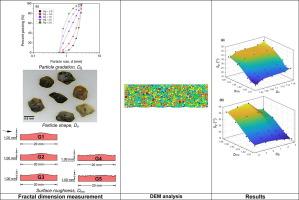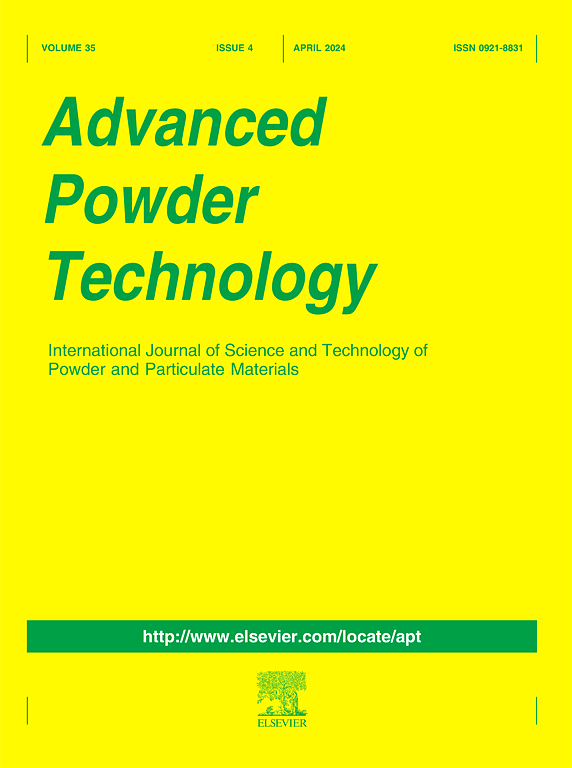Investigation of sand-geomaterial interface response using fractal theory: particle shape, gradation and surface roughness effects
IF 4.2
2区 工程技术
Q2 ENGINEERING, CHEMICAL
引用次数: 0
Abstract
The geometric properties of sand and geomaterials are considered to be the main factors affecting the interface response. The quantitative characterization of geometric parameters will enhance the engineering understanding of the interfaces. In this study, quantification of particle shape, gradation, and surface roughness parameters was performed with fractal geometry approach inspired by the irregular structures of the material geometries. The interface shear analyses were conducted to determine peak, residual interface friction and dilation angles, coordination number, and contact anisotropy using discrete element numerical method. The analysis parameters were calibrated with the experimental results of a custom-made transparent interface shear box using digital image processing. The analysis results show that the interface friction and dilation angles increase with increasing fractal dimension of particle shape and surface roughness. However, the friction angle exhibits a bell-shaped distribution with the change of the gradation fractal dimension. Moreover, the effect of the gradation fractal dimension on the friction angle differs depending on the roughness level. The rate of contact loss and contact anisotropy follow similar trends to the interface friction angle with changes in fractal dimensions. Considering the fractal dimension of the material geometries, macro and micro scale interface responses were defined and the correlation between these two scales was established.

基于分形理论的砂-岩土界面响应研究:颗粒形状、级配和表面粗糙度效应
砂土和岩土材料的几何特性是影响界面响应的主要因素。几何参数的定量表征将增强对界面的工程理解。在本研究中,颗粒形状、级配和表面粗糙度参数的量化采用分形几何方法,灵感来自于材料几何形状的不规则结构。采用离散元数值方法进行界面剪切分析,确定峰值、残余界面摩擦角、膨胀角、配位数和接触各向异性。采用数字图像处理技术,利用定制透明界面剪切箱的实验结果对分析参数进行校准。分析结果表明,随着颗粒形状分形维数和表面粗糙度的增大,界面摩擦角和膨胀角增大。摩擦角随分级分形维数的变化呈钟形分布。分级分形维数对摩擦角的影响随粗糙度的不同而不同。接触损失率和接触各向异性随分形维数的变化趋势与界面摩擦角相似。考虑材料几何形状的分形维数,定义了宏观和微观尺度的界面响应,建立了宏观和微观尺度之间的关系。
本文章由计算机程序翻译,如有差异,请以英文原文为准。
求助全文
约1分钟内获得全文
求助全文
来源期刊

Advanced Powder Technology
工程技术-工程:化工
CiteScore
9.50
自引率
7.70%
发文量
424
审稿时长
55 days
期刊介绍:
The aim of Advanced Powder Technology is to meet the demand for an international journal that integrates all aspects of science and technology research on powder and particulate materials. The journal fulfills this purpose by publishing original research papers, rapid communications, reviews, and translated articles by prominent researchers worldwide.
The editorial work of Advanced Powder Technology, which was founded as the International Journal of the Society of Powder Technology, Japan, is now shared by distinguished board members, who operate in a unique framework designed to respond to the increasing global demand for articles on not only powder and particles, but also on various materials produced from them.
Advanced Powder Technology covers various areas, but a discussion of powder and particles is required in articles. Topics include: Production of powder and particulate materials in gases and liquids(nanoparticles, fine ceramics, pharmaceuticals, novel functional materials, etc.); Aerosol and colloidal processing; Powder and particle characterization; Dynamics and phenomena; Calculation and simulation (CFD, DEM, Monte Carlo method, population balance, etc.); Measurement and control of powder processes; Particle modification; Comminution; Powder handling and operations (storage, transport, granulation, separation, fluidization, etc.)
 求助内容:
求助内容: 应助结果提醒方式:
应助结果提醒方式:


